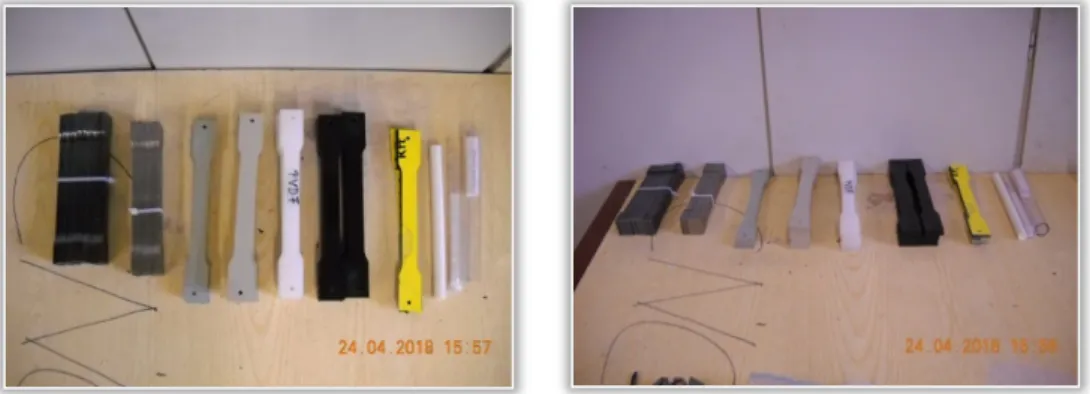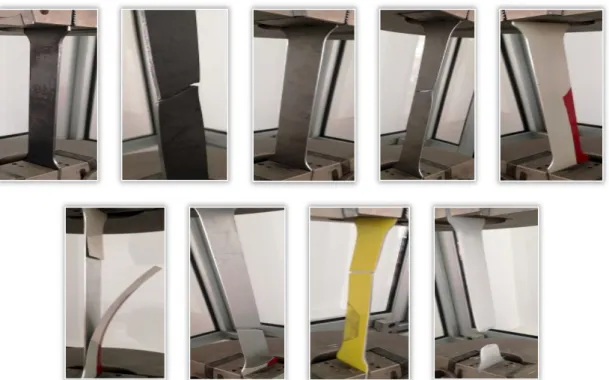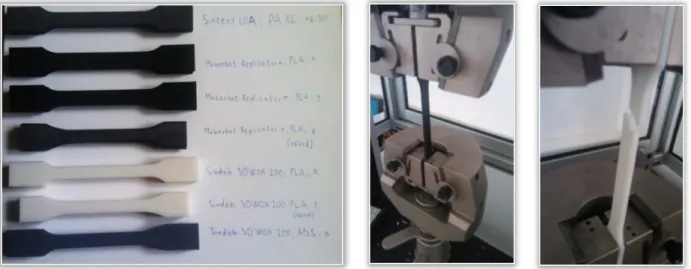1.
Tamás MOLNÁR,
2.Péter SZUCHY,
3.Sándor CSIKÓS,
4.
László GOGOLÁK,
5.István BÍRÓ,
6.József SÁROSI
MATERIAL TESTS AND ANALYSIS OF AIRCRAFT MATERIALS
1-6.Department of Technology, Faculty of Engineering, University of Szeged, Mars tér 7. 6724, Szeged, HUNGARY
Abstract: The payload is only 20% of a presently used cargo aircraft’s take-off weight, the circa half of the rest 80% is the empty weight. So it is obvious that reducing the empty weight improves significantly the economy, hence there is a huge demand in the aircraft industry for light structural materials with advanced parameters. Choosing a material is based on the following features: allowable stress, fatigue limit, crack-spread, corrosion, heat-resistance, accessibility and machinability, material cost and process resource demand. Our investigations focused on the tests of materials applied in aircraft’s wing structure that can be made of wood, metal, plastic and composite materials. We made tensile tests by the QUASAR 100 tensile strength-testing machine of University of Szeged, Faculty of Engineering. The standard test specimens were manufactured from different wing samples (steel, aluminium, plastic, composite) received from the Airport of Szeged. During the tests we analysed the upper and lower yield points, tensile strength, and elongation at rupture which features are essential from the point of view of their application.
Keywords: material tests, aircraft, tensile strength, yield point, elongation at rupture
1. INTRODUCTION
In this project our first step was to purchase and calibrate the necessary materials and instruments. The different composites, plastics and metals (non-alloy and alloy steels, corrosion-resistant and high-strength steels, aluminium and its alloys) used in aircraft industry were ordered from outer suppliers. The main goal was to analyse and compare such materials that are available from trade release.
We made contacts with the trading companies in Csongrád county where we could procure the structure materials S235, S275, S355 in different thickness. For purchasing technical plastics the Kár-Plaszt 2000 Kft. based in Szeged helped us with plastics produced (Fig. 1.) by them, so we could manufacture the standard test specimens.
Figure 1. Technological process and method of plastic welding
The aluminium alloys applied in aircraft industry were cut out at the airport of Szeged from the wing structure of a used fixed-wing aircraft (therefore we had got authentic values for the mechanical features), from which the tensile specimens were made (Fig. 2.).
2. MATERIALS AND METHODS
The composite materials consists of at least two macroscopically and functionally separable materials in a definite structure. The advantages of composites: significant weight reduction, anisotropy, incorrodible, weatherproof, long lifetime, resistance against fatigue, vibration damping, structural severity, formal freedom, aesthetic outfit, retentivity, reasonable heat-expansion, low “tooling” costs, reduced radar wave reflection, low maintenance and operation costs. The disadvantages of the composites: high process costs, low shock and damage resistance (carbon-, graphite-, boron-fibre), tendency to static charge, low lightning-endurance, lower interlayer strength, weak surface press strength, complicated and expensive repair costs, moisture intake, distortion, deformation at overheating, significant differences between tensile and press stress. [1]
The two components of the composites are the matrix and the reinforcement. The composites were developed for combining the benefits of the different materials’ advantageous physical parameters. The first “modern” composite (used even today) was the textile-bakelite that is a phenol formaldehyde resin enhanced by textile fibres. The resin is a really
rigid, frangible and weak plastic and only the enchantment with natural textile fibres made it suitable for wider industrial applications. The first composite applied in aircraft industry in bigger amount was a one-direction strip named GORDON AEROLITE developed by Aero Research Ltd. that was an untwisted line string impregnated by phenol resin in the ‘30s. The next step was the “marriage” of the high strength fibre glass and the polyester resin that was used first in 1943 for the rear part of the fuselage of a trainer plane (Vultee XBT-16) made in the USA with a honeycomb structure sandwich panel. In the aircraft industry appeared the epoxy-resin matrix materials that were first reinforced with fibre glass then carbon-, graphite- or aramid-fibres, boron-fibres, ceramic fibres or the combinations of them. [2]
Figure 2. Investigation of a lightweight, fixed-wing airplane built for sport purpose
Currently polyimide and bismaleimide basic thermosetting resins and thermoplastics are more significantly used for bedding the reinforcing fibres due to their higher temperature tolerance. Nowadays the modern composite materials are widely used for the airframe structure of the lightweight sport and general purpose airplanes and of the new generation military attack and fighter planes and helicopters. The reinforcing fibres of the composite materials have high tensile strengths and high Young-modulus, but their density is much lower than of the metals and in addition their structure can be anisotropic (generally orthotropic). Table 1 shows the physical features of the reinforcing fibres and metal alloys used in aircraft industry.
These values can decrease with 40-50% if the parallel fibres are bedded into matrix. But if first a traditional (plane: 00/900 grainline) texture is produced from the reinforcing fibre and then it is bedded into laminating resin, the tensile strength reduces further with its 50%, since this way only the half of the fibres laminated into the resin can be loaded into the same direction, and the other half can take the orthogonal force effects. [3-5]
The base materials of the composite technology in the aircraft industry: reinforcing materials (frame materials, reinforcing fibres), matrix materials (bedding materials), core materials, adhesives, bulking agents, additives. The reinforcing materials are one of the main component parts of the composite materials that ensure the mechanical strength and rigidity of the structure. Their most common manifestations: continuous filament, chopped fibre, whisker, but in the nanotechnology they can have tube or disc shape as well. Carbon fibres (HS, IM, HM, UHM), fibre glasses (“E”, “S”), aromatic polyamide fibres (Aramid, Kevlar, Nomex, Twaron, etc.), boron fibres, ceramic fibres (quartz, aluminium oxide, aluminium silicon, boron silicon, silicon carbide), mineral based reinforcing fibres (basalt) belong to them.
Table 1. Features of reinforcing fibres and metals
Materials Tensile strength
[MPa] Young modulus
[GPa] Density
[g/cm3] Specific modulus (Young mod. /density) High strength carbon fiber
(HS Carbon) 3800 160÷270 1,8 90÷150
Intermed. modulus carbon fiber
(IM Carbon) 5300 270÷325 1,8 150÷180
High modulus carbon fiber
(HM Carbon) 3500 325÷440 1,8 180÷240
Ultra-high modulus carbon fiber
(UM Carbon) 2000 >440 2,0 >240
Low modulus aramid fiber (Aramid LM) 3600 60 1,45 40
High modulus aramid fiber
(Aramid HM) 3100 120 1,45 80
Ultra-high modulus aramid fiber
(Aramid UHM) 3400 180 1,47 120
„E” Glass fiber („E” Glass) 2400 69 2,5 27
„S” Glass fiber („S” Glass) 3450 86 2,5 34
Quartz fiber (Quartz) 3700 69 2,2 31
Aluminum-zinc alloy (7075T6) 572 71,7 2,7 62
Titan alloy (Ti6Al4V) 950 110 4,5 24
Mild steel 450 205 7,8 26
Stainless steel (A5-80) 800 196 7,8 25
High-strength steel (17-4PH) 1340 196 7,8 25
The matrix materials create the mechanical connection between the separate reinforcing fibres, take the awakening shear stresses, preventing their movement to the others, ensuring the structural integrity. The core materials are the principal composer of the sandwich structural components. Their main task is to ensure the distance between the two coatings that take the pulling-pushing stresses. The process of the composite structures consists of usually several phases, the certain parts are produced individually, from which the complete unit is assembled after cutting to dimension and some finishing with fasteners or with structural adhesive bonding (epoxy resin, polyurethane adhesive, metacrylate adhesive).
The bulking agents are used for bonding the composite structures, increasing the viscosity, decreasing the density of the fluid resins used for filling up hollows. These are usually solid parts that increase the mechanical features of the base resin, make it more jelly-like and colourful. The additives help the production process but do not build into the product, they remain behind at the end of the process. [3-6]
3. RESULTS AND DISCUSSION
In the workshop of the University of Szeged, Faculty of Engineering, Department of Technology standard specimens were produced and the composition of metals were investigated. Figure 3 shows the result of material test of the aluminium alloy wing structure. [7-10]
Figure 3. Material test of the aluminium alloy wing structure
As a result of the tests the aluminium ID is EN AW 5083/H11 ”AlMg4.5Mn0,7 – EN AW 5083, H0/H111, unfinished, hot- rolled plate that has high strength, but still good flexibility, it is weldable and machinable. It replaces well the AlMg5 alloys, and it is the eminently used aluminium plate worldwide because of it’s multiple adaptability. The specimens were manufactured by milling machine with a former produced templet (Figure 4).
Figure 4. Standard specimen production with milling machine
The produced specimens were signed in order to be able to follow the results of the tensile tests and other investigations.
The specimens are shown on the Figure 5.
Figure 5. Standard specimens in the workshop of University of Szeged, Faculty of Engineering, Department of Technology
The tensile tests were executed at each kind of material (Figure 6.). During the tests we looked for different features of the materials,
— strength features: upper and lower yield points, tensile strength, contraction strength,
— ductility features: elastic limit, elongation at rupture, relative reduction of cross-section area.
The results are summarized in Table 2 and shown on Figure 7, 8 [7-10].
Figure 6. Tensile tests in the workshop of University of Szeged, Faculty of Engineering, Department of Technology
Figure 7. Results of tensile tests of specimens 1-3
Figure 8. Results of tensile tests of specimen 4-8 Table 2. Summary of results of tensile tests Specimen code Datum of test Thickness (a)
(mm) Width (b)
(mm) Ft
(N) Fm
(N) Rm
(N/mm2) Elongation:
[mm]
1. 15-05-2018 1,92 20 8666,5 16864 439,17 43,21
2. 15-05-2018 1,02 20 67 6354,5 311,5 26,74
3. 15-05-2018 0,9 20 -12 6428 357,11 2,7
4. 15-05-2018 2 20 57,5 1515,5 37,89 390,1
6. 15-05-2018 4 20 96 3068,5 38,36 41,32
7. 15-05-2018 6 20 98 2377,5 19,81 57,31
8. 16-05-2018 1 20 50,5 1791 89,55 16,1
Extending the group of materials we involved 3D printed plastic materials into the investigations. We printed specimens with different fibre direction and filling parameters (Figure 9). The development of 3D printing governed our attendance to its investigation, the results are shown in Table 3.
Figure 9. 3D printed specimens with different fibre direction and filling parameters Table 3. Results of tensile tests of 3D printed specimens
Specimen code Date of test Thickness (a)
(mm) Width (b)
(mm) Ft
(N) Fm
(N) Rm
(N/mm2)
Rep_PLA_X 30-05-2018 4,2 10 69 1412,5 33,63
Rep_PLA_X 30-05-2018 4,18 10 78,5 1372,5 32,83
Rep_PLA_X 30-05-2018 4,2 10 96 1237,5 29,46
Rep_PLA_Y 30-05-2018 4,2 10 55,5 1175 27,98
Rep_PLA_Y 30-05-2018 4,2 10 67,5 1428,5 34,01
Rep_PLA_Y 30-05-2018 4,18 10 60,5 1178 28,18
Rep_PLA_Z 30-05-2018 4 9,74 95 1213,5 31,15
Rep_PLA_Z 30-05-2018 3,9 9,8 51 1321,5 34,58
Rep_PLA_Z 30-05-2018 3,9 9,75 69 1334,5 35,1
200_PLA_X 30-05-2018 10,05 4,05 82 1499,5 36,84
200_PLA_X 30-05-2018 4,06 10,05 93 1521,5 37,29
200_PLA_X 30-05-2018 4,05 10,06 92,5 1344 32,99
200_PLA_Y 30-05-2018 4,01 9,94 73,5 1181,5 29,64
200_PLA_Y 30-05-2018 4,01 10,02 91,5 1117,5 27,81
200_PLA_Y 30-05-2018 4,02 9,92 78,5 1129,5 28,32
200_ABS_X 30-05-2018 4,13 10,3 93,5 1423,5 33,46
200_ABS_X 30-05-2018 4,18 10,28 82 1431,5 33,31
200_ABS_X 30-05-2018 4,16 10,3 97,5 1403 32,74
Lisa_PA_XY30 30-05-2018 4 9,9 -169,5 808 20,4
Lisa_PA_XY30 30-05-2018 3,93 9,78 -125 651,5 16,95
Lisa_PA_XY30 30-05-2018 3,98 9,8 -158,5 653,5 16,75
4. CONCLUSIONS
Application of the polymers and composites as structure material is really prevailing due to their excellent mechanical, physical and chemical features. The low density with high strength, the damping and insulating capability, the chemical and corrosion resistance, the proposable anisotropy made the synthetic polymers one of the favourite materials nowadays.
With their application we can save energy and make steps forward the sustainable development. The present polymer researches trend to the energy savings, green solutions that make our life more comfortable and easier.
Acknowledgements
The project has been supported by the European Union, co-financed by the European Social Fund. EFOP-3.6.1-16-2016-00014.
Authors are thankful for it.
Note
This paper is based on the paper presented at International Conference on Science, Technology, Engineering and Economy – ICOSTEE 2018, organized by University of Szeged, Faculty of Engineering, Szeged, HUNGARY, in Szeged, HUNGARY, 25th October, 2018.
References
[1] Czvikovszky – Nagy – Gaál: A polimertechnika alapjai, Műegyetemi Kiadó, 2000
[2] Gáthi Balázs – Koncz Imre: Repülőgépek szerkezete, A II. Nemzeti Fejlesztési Terv Társadalmi Megújulás Operatív Program TÁMOP-4.1.2/A/2-10/1-2010-0018 azonosító számú programja keretében készült jegyzet. 2011.
[3] Lukács – Csomós – Gácsi - Karcagi – Magyar – Tomolya: Fáradásos repedésterjedés különböző típusú kompozitokban, Anyagvizsgálók Lapja, 2004/4
[4] Koncz – Magyarosi – Pusztai: Kompozitok és szendvicsszerkezetek - Repülőgép kompozit szerkezetjavító szakmai oktatási jegyzet, 2000
[5] Pukánszky B., Móczó J.: Műanyagok. Typotex kft., Budapest, Magyarország (2011).
[6] Czél G., Jalalvand M., Wisnom M.R.: Demonstration of pseudo-ductility in unidirectional hybrid composites made of discontinuous carbon/epoxy and continuous glass/epoxy plies. Composites Part A: Applied Science and Manufacturing, 72, 75-84 (2015).
[7] Gunczer L.(2009): Anyagismeret és Gyártástechnológia jegyzetmodulok.
[8] Gunczer L. (2009):, Anyagvizsgálatok. SZTE MK, Szeged 2009.
[9] Mészáros-Varnyú (2009): Műszaki anyagismeret (CooSpace elektronikus jegyzet).
[10] Gunczer L. (2009): Anyagszerkezettan és gyártástechnológia, Egyéb anyagok (kiegészítés). SZTE Univ Kiadó, Szeged 2009.
ISSN 1584 - 2665 (printed version); ISSN 2601 - 2332 (online); ISSN-L 1584 - 2665
copyright © University POLITEHNICA Timisoara, Faculty of Engineering Hunedoara, 5, Revolutiei, 331128, Hunedoara, ROMANIA
http://annals.fih.upt.ro




